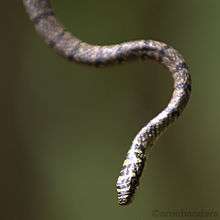Chrysopelea taprobanica
| Sri Lankan flying snake | |
|---|---|
 | |
| At Kandalama. | |
| Scientific classification | |
| Kingdom: | Animalia |
| Phylum: | Chordata |
| Class: | Reptilia |
| Order: | Squamata |
| Suborder: | Serpentes |
| Family: | Colubridae |
| Genus: | Chrysopelea |
| Species: | C. taprobanica |
| Binomial name | |
| Chrysopelea taprobanica | |
Chrysopelea taprobanica, the Sri Lankan flying snake[2][3][4] or Indian flying snake,[1] is a species of gliding snake distributed in India and Sri Lanka.[1][5] It can glide, as with all species of its genus Chrysopelea, by stretching the body into a flattened strip using its ribs. The snake is known as "dangara dandaa - දඟරදන්ඩා" in Sinhala, due to its folding postures.
Description
Chrysopelea taprobanica is a medium-sized snake, reaching 60–90 cm (24–35 in) length. The head is depressed. Eyes are large with round pupils. Ventral scales have keels laterally. Vertebral scales are not enlarged. Dorsal scales are smooth or feebly keeled. Dorsal side is greenish yellow or pale green. Orange to red spots can be seen between dark cross bands. Head is black dorsally with yellow and black cross-bars. Ventral side is pale green with a series of black lateral spots on each side.[4]

Scalation
There are 198–214 ventral scales and 107–123 subcaudal scaless.[4]
Ecology
The snake inhabits old growth trees, as well as secondary vegetation, cultivation, sometimes entering human dwellings. They are diurnal and arboreal.[4]
Diet
Mainly comprises with lizards, such as geckos and agamids. Bats, rodents, birds and other small snakes may also be taken.[4]
Distribution
The Sri Lankan flying snake population in Sri Lanka can be found in dry zone lowlands and parts of the intermediate climatic zones, including Polonnaruwa, Wilpattu National Park, Sigiriya, Kurunegala, Jaffna, Trincomalee, and Monaragala.[4] This species was believed to be endemic to Sri Lanka until researchers recorded few specimens from Andhra Pradesh (India)[6][7] and found old museum specimens collected from India that are now assigned to this species.[5]
Reproduction
Relationship with humans
Because this species is uncommon, arboreal, and prefers forests, it is rarely encountered by humans. One bite has been reliably documented, resulting in mild local effects only.[2]
References
- 1 2 3 4 Chrysopelea taprobanica at the Reptarium.cz Reptile Database. Accessed 18 September 2018.
- 1 2 Silva, Anjana; Weerawansa, Prasanna; Pilapitiya, Senaka; Maduwage, Thilina & Siribaddana, Sisira (2013). "First authenticated case of Sri Lankan flying snake (Chrysopelea taprobanica) bite". Wilderness & Environmental Medicine. 24 (3): 273–276. doi:10.1016/j.wem.2013.01.008.
- ↑ "Snakes of Sri Lanka". Biodiversity of Sri Lanka. Retrieved 18 September 2018.
- 1 2 3 4 5 6 7 "Sri Lankan Flying snake". Sri Lanka Reptile. 1997–2009. Archived from the original on 18 September 2018. Retrieved 18 September 2018.
- 1 2 Somaweera, R.; Pantoja, D. L. & Deepak, V. (2015). "Forgotten records of Chrysopelea taprobanica Smith, 1943 (Squamata: Colubridae) from India". Zootaxa. 3947 (4): 597. doi:10.11646/zootaxa.3947.4.11.
- ↑ Guptha, Bubesh; Prasad, Nimmakayala Venkata Sivaram; Maddock, Simon T. & Deepak, V. (2015). "First record of Chrysopelea taprobanica Smith, 1943 (Squamata: Colubridae) from India". Check List. 11 (1): 1–3. doi:10.15560/11.1.1523.
- ↑ Rangarajan, A.D. (1 January 2015). "Sri Lankan snake sighted in Seshachalam". The Hindu. Retrieved 16 September 2018.